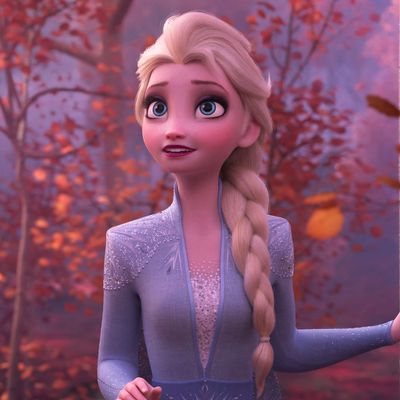
Elsa does not get a girlfriend in Frozen II, with condolences to the fans who pleaded to Disney for one, like supplicants petitioning an indifferent corporate god. The frosty former princess does, however, get a magical horse, and it’s pretty sick. It is, technically, a water spirit called a Nokk, but what matters is that it’s crystalline and capable of galloping across the surface of the ocean in a way that both looks cool and makes Elsa’s silver hair, unleashed from its braid, flutter aspirationally in the wind. That’s the kind of sight that you can imagine making a child’s heart explode with covetous delight, especially one of the little girls who were key to making the first Frozen a beast of a $1.27 billion global hit in 2013, and who pushed its breakout ballad “Let It Go” into brain-melting inescapability.
Frozen II is, like its predecessor, a kids’ movie, but it’s also, like its predecessor, an official Walt Disney Animation Studios release, which means it’s a vector for merchandise, music, theme-park rides, eventual remakes, and a young generation’s pop cultural pressure points. There is every possibility that “Into the Unknown” — the new designated banger from songwriting team Kristen Anderson-Lopez and Robert Lopez, featuring the same sort of soaring chorus and the same high note as Let It Go — will become aural wallpaper in the houses and vehicles of families around the world. The tendency people have developed to talk about these movies as bearing a public responsibility is both a symptom of our disturbingly parasocial relationship with a massive media conglomerate, and an acknowledgment of that massive media conglomerate’s awesome reach and influence. Disney doles out its milestones of representation in intensely calculated dribs and drabs. It’ll only give one of its princesses more than an “exclusively gay moment” once its sure it can maximize plaudits for its progressiveness while preserving its bottom line in more repressive international regions.
It’s easier to think about Frozen II as a product than as a film because a (sometimes stunning-looking) product is all that it feels like. It was directed by Chris Buck and Jennifer Lee, the team behind the first film, from a script that Lee wrote, and that never really pretends that it exists because the story, rather than the market, demanded more. That story has the feel of the kind of invented errand that used to fuel countless direct-to-video sequels, only this one’s been blown up to a grand scale, with accompanying sumptuous production values. Elsa (voiced by Idina Menzel) is now queen of the hygge-heavy kingdom of Arendelle, though she’s distracted by a haunting call that only she can seem to hear. Kristoff (Jonathan Groff), still accompanied by his reindeer, Sven, is working his way up to proposing to Elsa’s sister, Anna (Kristen Bell). Then there’s the snowman. There is, I regret to inform you, an awful lot of the snowman, Olaf (Josh Gad), which, alongside Elsa’s ascendance to lead, indicates that some fan demands were heeded.
The group hauls off to the north in order to save Arendelle from a plot device, finding their way to an enchanted forest that’s home to the Sámi-inspired Northuldra tribe. The Northuldra, led by Yelana (Martha Plimpton), have a fraught history with Arendelle, once approached as allies until something went wrong and the area was sealed off by mist. The mystery behind these events will turn out to involve the colonialist ambitions of a past king and a betrayal that reveals that illustrious ancestors are rarely all they’re idealized to be — ambitious stuff from the company that made Pocahontas, though the inevitable happy resolution suggests that these films still aren’t exactly up to reckoning with restitutions for inherited trauma. That mystery, anyway, becomes intertwined with a journey of self-discovery involving an explanation for Elsa’s powers, and while that resolves in a sequence that I’m still not entirely sure I understand, it does manage to once again gift the character with a gleaming new outfit.
It’s hard not to feel jaded about Frozen II, while also understanding that those feelings don’t matter at all, and that the film is going to go on to draw huge audiences heavy on children and accompanying parents who’ll appreciate being thrown a bone by way of Kristoff’s amusingly ’80s-rock-inflected number. The film comes from a tradition that has spawned both incredible classics of animated artistry and overtly calculating entertainments, and it happens to skew more toward the latter. It’s carefully modulated to reach the widest possible audience while offering just enough for the adults in the room to shrug and think, Hey, at least these are strong female characters, right? And the thing is that, even as a mostly mercenary endeavor, the movie is still capable of moments of astonishing beauty. Take, for instance, the sequence in which Elsa attempts to cross a stormy sea, trying and failing to use ice to crest the raging waves. It’s in those waters that she battles the Nokk, eventually finding a way to get on its back and ride away triumphant. Adult me knows that thing is already available in toy stores, but child me would have died to have one.


